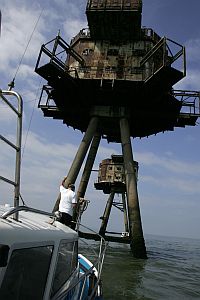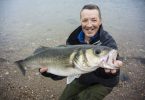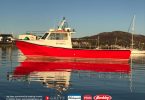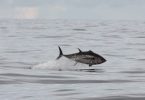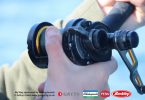Boat Fishing Monthly editor Dave Barham reveals an exciting method for catching bass by bouncing live peeler crabs on the sea bed
A Day On The Bass
When I first received the call from BFM contributor Ryan Lynch asking if I’d like a day out bass fishing on his mate Pete’s boat I jumped at the chance. Little did I know that the pair had planned a day fishing the famous World War Two gun forts in the Thames Estuary.
 Excellent Plan
Excellent PlanThe day of the trip dawned sunny with very little in the way of wind- perfect for tying up in among the forts. On the way out, Ryan explained that we would be fishing live peeler and ‘jelly’ crabs for the bass and began to explain the rig and method to me. As we steamed ever closer it dawned on me that the method being used was one that was new to me, and one that I had never read about before for targeting bass. So I asked the guys if it was okay for me to ‘lift the lid’ on the method and here we are!
Simple Tackle
In order for this tactic to work you need to use a fairly beefy outfit that can handle the ‘hit and hold’ style of angling that the method dictates. For this reason you’ll need a 12lb to 20lb class rod matched with a multiplier reel loaded with either 30lb braid or 20lb mono. You’ll also need an assortment of leads from 2oz up to 10oz, depending on the strength of the tide and depth of water that you’ll be fishing.
Simple Rig
The less terminal tackle you use the better, and by far the easiest thing to do is to tie a blood loop into your shockleader (or main line if you’re using mono) to form the rig. What you’re looking for is a simple paternoster-style rig where the hooklength is the same length as the bottom part of the trace – i.e. your baited hook sits right on the lead once baited up and ready to go. It’s also a good idea to incorporate some form of rotten bottom weak link into the rig where the lead is attached – this will save on lost fish should the lead become snagged. Make sue you use a good quality, ultra-sharp hook on the business end. Something like a size 5/0 Sakuma Manta or Varivas Big Mouth is perfect.
The Method
The aim of the game is to hook the crab, be it a peeler or jelly, through the back leg sockets to give as natural presentation as possible. Once tied up to or anchored into your chosen structure you simply lower the baited rig directly over the side. This is proper ‘up and down’ fishing, and you need to aim to keep your baited trace directly under the rod tip. Once on the sea bed, keep your lead ‘bouncing’ by gently lifting and lowering your rod tip every minute or so. Doing this ensures that your bait is always as close to the sea bed as possible, and not drifting off in the tide.

 Hold On!
Hold On!
Because this method of fishing invokes a really vicious attack from any hungry bass it is essential that you keep hold of your rod at all times. This is definitely not the method to use if you want to sit back and relax for your day afloat – you need to be switched on and ready to go at a millisecond’s notice! You may have to wait for an hour for a bite but, as was the case on this trip, bites can come instantly. And, when you do get that all-important bite you’ll be amazed at just how powerful it is! It feels like you’re having the rod wrenched from your hands, even with a moderately small three-pounder.
Play It Cool
It’s important that you have your drag set up correctly, so that a hooked fish can take a small amount of line, but not too much that it can easily find the sanctuary of a snag. A little practise will soon give you an idea of how far you can push things. Then it’s simply a case of hitting the bite and holding on for dear life while trying to stop the angry bass for snagging you so you can bring it safely to the net.
Not Just The Forts
This method can be utilised pretty much anywhere that has bass feeding in and around a submerged structure. This includes around piers and breakwaters, shallow water wrecks, reefs and general broken ground. Although the Thames is a tidal estuary, you could use this method in open sea – providing the tides aren’t ridiculously strong.
Great Trip
During our session we got stuck into nine bass ranging from 3lb up to 5lb, and I can’t wait to go back and have a crack at some larger fish. One thing is for sure though – bottom bouncing with live crabs certainly works, and I’ll be trying it out at different venues over the coming months. I can’t believe I’ve never tried it before for bass – it’s a similar technique for catching wrasse, but I just simply never though of using it. Give it a go yourself and see just how exciting and productive it can be. Wait for that electric shock sensation that runs up your arms as the bass hits you hard and the adrenaline fires into your blood stream – it’s awesome!

For more great features, tips and advice, visit
www.boat-fishing-monthly.co.uk

